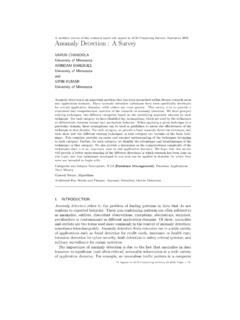Transcription of Seasonal Climate Forecast: October-December 2021
1 Seasonal Climate ForecastMarch May 2018 Issued: February 16, 2018 Contact: ODF Meteorologist Pete Parsons503-945-7448 or Department of Agriculture (ODA) -Oregon Department of Forestry (ODF)ODAP roduction support from Diana Walker, Jacob Cruser, and Andy ZimmermanEl Ni o Southern Oscillation (ENSO)Current Status and ForecastnLa Ni a (cold) conditions are present, with below-average sea-surface temperatures (SSTs) in the central and eastern tropical Pacific Oceanic Ni o Index (ONI) for Nov. Jan. was C. This index, which lags real-time SSTs, is in La Ni a territory for the third consecutive month (The Climate Prediction Center s definition of a La Ni a Eventincludes an ONI value of C or colder, for at least 5 consecutive months).
2 NThe current Climate Prediction Center (CPC) forecast favors La Ni a conditions through this winter, with a transition to ENSO-neutralin the spring. However, some computer models show La Ni a continuing at least through the summer, especially NCEP s CFSv2 forecast NOTE: Beginning with the October 2017 update, ONI values use ERSSTv5 data (Huang et al. 2017, J. Climate , vol. 30, 8179-8205). OverviewnThis month s analog years (1963; 1996; 2006) remain unchanged, even though they show considerable variability among themselves and are not strong matches to the current year, which has La Ni a general, La Ni a events exhibit an enhanced influence from the polar jet stream, over the Pacific Northwest, during the spring months.
3 That increases the chances for cool temperatures and some recovery of mountain snowpacks, which are currently well-below average (next slide).nThe wide variety of weather conditions exhibited by the analog years, typical of La Ni a events, decreases forecast NOTE: This forecast is based on past and current weather data and is notassociated with CPC predictions (see Forecasting at: )northe official CPC Three-Month Outlooks, which are available here: SST Anomalies ( C)2018 Composite: 1963; 1996; 2006nThe January 2018 observed Pacific Basin SST anomaly pattern is similar to the constructed January composite of the analog years (1963; 1996; 2006).
4 NBoth graphics show cool SST anomalies in the tropical Pacific and across parts of the north Pacific Ocean. There are also obvious differences, especially in 2018 Pacific SST anomalies were negative in the tropics and portions of the Gulf of AlaskaAnalog composite of Pacific SST anomalies has a similar patternPacific OceanAnimated (PowerPoint only) SSTs (top) / Anomalies (bottom)Courtesy: and eastern tropical Pacific SSTs are in weak-to-moderate La Ni a Pacific OceanCurrent SST anomalies (bottom) reflect La Ni a (cold) conditionsCourtesy.
5 And eastern Pacific SSTs remain below averageENSO-neutralTropical Pacific OceanEl Ni oLa Ni a(1962-63;1995-96;2005-06)January 2018 SOI climbed into La Ni a territorySOIs of the analog years were all in the La Ni a rangeStrongModerateENSO-neutralEl Ni oTropical Pacific Ocean(1962-63;1995-96;2005-06)La Ni aWeakStrongModerateONI for Nov. 2017 Jan. 2018 bordered on moderate La Ni aONIs of the analog years ranged from cold ENSO-neutral to moderate La Ni a WeakNeutralNorth Pacific OceanWar mCool(1962-63;1995-96;2005-06)Jan.
6 2018 PDO warmed to the top end of the neutral rangeJan. PDO of analog years ranged from slightly warm to neutral March 2018 ForecastMean Upper-Air PatternUpper-Air AnomaliesnColder-than-average air aloft would promote below-average snow levels over variation among the analog years continues to reduce forecast 2018 ForecastTemperaturesPrecipitationnTemper atures likely a little below near to slightly-below recovery of mountain snowpacks, relative to 2018 ForecastMean Upper-Air PatternUpper-Air AnomaliesnThe analog composite favors anomalous troughingin the Gulf of Alaska and off of the US west predicted mean upper-air pattern favors increased storm activity, relative to 2018 ForecastTemperaturesPrecipitationnSlight ly-cooler and wetter-than-average weather likely.
7 Below average freezing levels should slightly delay the spring melting of still have considerable variation in both categories, which is common during La Ni a 2018 ForecastMean Upper-Air PatternUpper-Air AnomaliesnAnomalous troughingshifts to just off the west coast, with enhanced SW flow aloft indicated for mean upper-air pattern would bring above-average cloudiness and precipitation, especially across the western 2018 ForecastTemperaturesPrecipitationnAnalog years showed significant variation in temperature, with their resultant average near or slightly-below normal.
8 NAbove-average storminess should suppress maximum temperatures, and bring above-average precipitation, especially west of the May 2018 ForecastMean Upper-Air PatternUpper-Air AnomaliesnAnomalous troughingover the Pacific NW, during March and April, is expected to shift westward in May, producing enhanced SW flow some late-season recovery of mountain snowpacks, but reaching average Seasonal totals will be May 2018 ForecastTemperaturesPrecipitationnAnalog years still show considerable variation in temperatures but are more consistent with a signal for above-average Ni a events enhance the chances for late-season valley frost and delayed spring snowmelt in the ResourcesnCPC Official US Three-Month Forecasts (Graphics): US 30-Day & 90-Day Forecasts (Discussions): Weekly & Monthly ENSO Discussions: Government Weekly Tropical Climate Note: Government ENSO Wrap-Up.
9 ENSO Quick Look: Seasonal Climate Forecast Home: Supply InformationnNDMC Drought Monitor: North American Drought Portal: Snow Water Equivalent Oregon Map: Snow Water Equivalent Products: Weekly Water and Climate Update: Western Snowpack Data & Water Supply Forecast: WestWideDroughtTracker: Monthly(Around the 20th)Contact: Pete Parsons, ODF Meteorologistat 503-945-7448 or Feedback is Welcome!Sign-up for Email Notification of Updates at.











